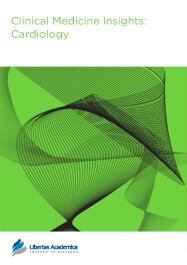

Publication Date: 30 Aug 2011
Type: Original Research
Journal: Clinical Medicine Insights: Cardiology
Citation: Clinical Medicine Insights: Cardiology 2011:5 77-83
doi: 10.4137/CMC.S7189

Aims: This study investigated the prognostic value of B type natriuretic peptide (BNP) in acute myocardial infarction (AMI) patients and its relation with left ventricular function and post-myocardial infarction complications.
Methods: In this cross-sectional study, plasma BNP level was measured for 42 consecutive patients (mean ± SD: 61.6 ± 10.85 years old) with acute ST elevation myocardial infarction (MI) and 42 healthy, age and gender matched subjects.
Result: BNP level in AMI patients were significantly higher than control group (P < 0.001). Regarding to infarct location, the highest BNP level measured in inferoposterior MI (BNP = 4436.63 ± 6188.159 pg/ml) and the lowest one indicated in standalone inferior MI (BNP = 598.83 ± 309.867 pg/ml (P = 0.071). There was significant reverse relation between BNP and EF (P = 0.006,
OR = -0.47) and a significant relationship between BNP and killip classification (P = 0.036). There was no significant relation between diastolic and right-ventricular function and BNP level (P = 0.61,
P = 0.21). The highest BNP level was detected in LV septal rupture and false aneurysm (P = 0.02) and in ventricular tachycardia, but without significant relationship (P = 0.25).
Conclusion: After the onset of AMI, BNP blood level can be used as an important predictor for left ventricular dysfunction, killip classification, early mechanical complications and cardiac death.
PDF (550.76 KB PDF FORMAT)
RIS citation (ENDNOTE, REFERENCE MANAGER, PROCITE, REFWORKS)
BibTex citation (BIBDESK, LATEX)
XML
PMC HTML

I am impressed by the efficiency at each step of submission in the journal. Based on the first-hand experience, I am confident that this journal will have a great future, and the impact factor will rise rapidly.

All authors are surveyed after their articles are published. Authors are asked to rate their experience in a variety of areas, and their responses help us to monitor our performance. Presented here are their responses in some key areas. No 'poor' or 'very poor' responses were received; these are represented in the 'other' category.See Our Results
Copyright © 2013 Libertas Academica Ltd (except open access articles and accompanying metadata and supplementary files.)
Facebook Google+ Twitter
Pinterest Tumblr YouTube